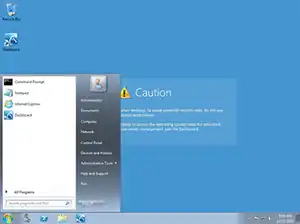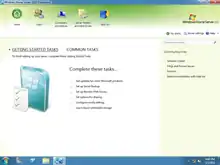Windows Home Server 2011
Windows Home Server 2011, code named Vail,[2] is a home server operating system by Microsoft designed for small office/home offices[3] and homes with multiple connected PCs to offer protected file storage, file sharing, automated PC backup, remote access, and remote control of PC desktops.[4] It was released on 6 April 2011[1][5][6] following the release of Power Pack 3 for its aging predecessor, Windows Home Server. Windows Home Server 2011 is the last Windows Home Server release[7] and was succeeded by Windows Server 2012 Essentials.[8]
| Version of the Windows NT operating system | |
 Windows Home Server 2011 desktop | |
| Developer | Microsoft |
|---|---|
| Source model | |
| Released to manufacturing | 6 April 2011[1] |
| Update method | Windows Update |
| Platforms | x86-64 |
| Kernel type | Hybrid |
| License | Proprietary commercial software |
| Preceded by | Windows Home Server (2007) |
| Succeeded by | Windows Server 2012 Essentials (2012) |
| Official website | www |
| Support status | |
| Unsupported as of April 12, 2016 | |

Windows Home Server 2011 is based on Windows Server 2008 R2 and requires x86-64 CPUs (64-bit), while its predecessor worked on the older IA-32 (32-bit) architecture as well. Coupled with fundamental changes in the structure of the client backups and the shared folders, there is no clear method for migrating from the previous version to Windows Home Server 2011.[9]
Features
Windows Home Server 2011 includes additional entertainment capabilities, and an add in feature with an app store.[2] Including web-based media functionality.[10][11][12]
Initial speculation by technology columnist Mary Jo Foley fueled the idea that 'Vail' would integrate with Windows Media Center. This prompted the response "Time will tell" by Microsoft Windows Home Server Product Planner Todd Headrick,[2] but by the time of the public beta Microsoft had decided not to integrate Windows Media Center with 'Vail'.[13]
System requirements
| Component | Required specifications |
|---|---|
| CPU | 1.3 GHz dual core or 1.4 GHz single core; x86-64 architecture |
| RAM | 2 GB (8 GB Maximum) |
| Hard disk space | At least one 160 GB drive |
Drive Extender removal
On 23 November 2010, Microsoft announced that Drive Extender would be removed from Windows Home Server 2011.[15] This announcement has led to "astonishment and outrage" from testers and users.[16] Criticism of Drive Extender's removal is mainly related to it being seen as a core feature of Windows Home Server and a key reason for adoption. Windows Home Server 2011 developer Michael Leworthy expressed concern that the implementation of Drive Extender might lead to "data error issues."[17] As a result, third-party products entered the market to fill the void left by Drive Extender, including Drive Bender (Division M) and DrivePool (StableBit).[18]
The volume spanning feature of Drive Extender, in which two or more drives are used as one large storage volume, is available using the Dynamic Disks feature as in any other Windows Server release.
References
- Kean, Kevin (6 April 2011). "Windows Home Server 2011 now available for TechNet and MSDN Subscribers to Download today!". Windows Home Server Blog. Microsoft. Archived from the original on 8 April 2011.
- Foley, Mary Jo (25 February 2008). "Windows Home Server 'Vail' to get more entertainment hooks". ZDNet. CBS Interactive.
- Foley, Mary Jo (9 November 2009). "Which should a small business choose: Windows Home Server or Windows Server Foundation?". ZDNet. CBS Interactive. Retrieved 2 February 2010.
- "Bill Gates Unveils Windows Home Server at the 2007 International Consumer Electronics Show". News Center. Las Vegas: Microsoft. 8 January 2007. Retrieved 8 January 2007.
- "Windows Home Server 2011 is Ready for Release". Windows Home Server Blog. Microsoft. 29 March 2011. Archived from the original on 1 April 2011.
- Foley, Mary Jo (29 March 2011). "Microsoft releases Windows 'Vail' server to manufacturing". ZDnet. CBS Interactive.
- "Microsoft confirms enthusiasts' fears: No more versions of Windows Home Server". ZDNet. CBS Interactive. 5 July 2012.
- "Windows Server 2012 Essentials Frequently Asked Questions" (PDF). Microsoft. pp. 4–5. Archived from the original (PDF) on 31 August 2012. Retrieved 29 December 2012.
- Clark, Jim (11 April 2011). "How to: Upgrade to Windows Home Server 2011 (Part 1)". We Got Served. Archived from the original on 13 April 2011.
- Foley, Mary Jo (27 January 2010). "Early version of Windows Home Server 'Vail' leaks to the Web". ZDNet. CBS Interactive.
- Whittaker, Zack (28 January 2010). "Windows Home Server 'Vail': A web based media center?". ZDNet. CBS Interactive.
- Thurrott, Paul (2 September 2011). "Windows Home Server 2011". SuperSite for Windows. Penton. Archived from the original on 7 October 2011.
- Walsh, Terry (26 April 2010). "What's New in Windows Home Server Vail?". We Got Served. Archived from the original on 19 August 2010.
- "System Requirements". Windows Home Server 2011 Online Help. Microsoft. 30 March 2011. Archived from the original on 24 December 2011.
- Leworthy, Michael (23 November 2010). "Windows Home Server code name "Vail"– Update". Windows Home Server Blog. Microsoft. Archived from the original on 29 April 2014.
- Bright, Peter (26 November 2010). "Has Microsoft just ruined Windows Home Server?". Ars Technica. Condé Nast.
- Bott, Ed (30 November 2010). "How Microsoft can clean up the mess in its home and small business server business". ZDNet. CBS Interactive.
- Walsh, Terry (10 October 2011). "Drive Bender Public Release Arriving This Week". We Got Served. Archived from the original on 12 October 2011.